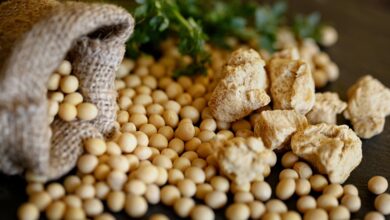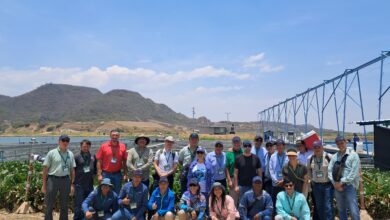

The Benefits of U.S. Soy for Human Consumption
Nourishing the world with essential nutrients for both people and animals
Proteins are the basic building blocks of global nutrition, whether they are used for human consumption or in feed that nourishes the meat protein we consume.
As the global population rises to an estimated 10 billion people by 2050, U.S.-grown soybeans can fulfill an essential role in feeding the world sustainably.
By creating soy foods made with U.S. Soy, you in turn play an important part in global food and nutrition security, and you are ensured a reliable supply of high-quality protein. Whether you are producing soy milk, tofu, edamame, natto, tempe or even meat alternatives, you will find the functionality and versatility you need to put your formulations in high demand.
Soy – the Protein Powerhouse
Soybeans are considered a nutritional powerhouse, with their high protein content and complete nutritional profile. Soy protein contains all nine essential amino acids required to meet the nutritional needs of both children and adults. It is a staple for vegetarians and vegans and an excellent choice for people who want to increase plant protein intake.
Superior Plant Protein
Not only is it a high-quality protein comparable to animal protein, soy protein is higher quality than nearly all other plant proteins. And the benefits of soy protein just keep going2:
- Source of folate, potassium and fiber
- Directly lowers blood cholesterol levels
- Has been shown to lead to similar gains as supplementation with whey protein in strength and muscle mass among individuals engaged in resistance exercise training

How U.S. Soy Is Used in Soy Foods
In Asia and the rest of the world, consumer demand for soy foods is increasing. Growing populations and a rising middle class are working in tandem to drive protein consumption.
Soy protein is a high quality, reliable, affordable choice that is easy for you to incorporate in foods and formulations. The upward trend toward higher protein consumption impacts traditional soy foods and influences the inclusion of soy as an ingredient in many new foods, including meat alternatives.
U.S. Soy is well positioned to help you create sustainable, reliable solutions to answer consumers’ soy foods demands.
For an in-depth look at how the Asian market consumes soy foods, check out USSEC’s Asia Soy Foods Report.

U.S. Soy – the Premier Sustainable Plant Protein
Consumers worldwide continue to prioritize sustainability in their foods, and soy products are an excellent answer to those demands. For the soy foods you produce, U.S. Soy stands out as the most sustainable source of plant protein globally.3 The carbon footprint of U.S. Soy is lower than:
- Soy produced in Brazil, Argentina and Canada
- Other plant-based proteins like peas from Canada, Russia and France
- Chickpeas from Australia and India
- Broad beans from the European Union and Australia

Sustainable U.S. Soy Label
As a soy foods manufacturer, you can meet consumer demands for sustainability by using the Sustainable U.S. Soy label on your consumer-packaged soy products. The label is used to promote products produced using soy verified through the U.S. Sustainability Assurance Protocol.
U.S. farmers and suppliers prioritize excellence in providing soy food beans, soybean meal and soybean oil, driving innovation through investments in genetics.

U.S. Soy Food Crop Update
Stay up to date on specialty soy crop progress in regions across the U.S. throughout the growing season with USSEC’s Soy Food Crop Update. Prepared in collaboration with industry partners, it provides an inside look at sustainable food bean production on U.S. Soy farms.

Specialty U.S. Soy Database
The Specialty U.S. Soy Database is your premier destination for sourcing U.S. soybeans to use in your soy products. Featuring nearly 500 varieties, this is the most comprehensive database of U.S. soybeans available for use in soy-based foods such as tofu, soy milk, natto and miso. The database provides data on quality attributes such as oil and protein content, amino acid content, origin and more.

Non-GMO Soybeans Study
Find updated information about production in the U.S., end use, and trends in non-GMO planting in USSEC’s Non-GMO Soy Foods Acreage Report. U.S. non-GMO production covers a vast geographic area, allowing for a diverse selection of soybean varieties while mitigating weather-related concerns.
Non-GMO soy food beans production has been stable over the past year and continues to account for the bulk of non-GMO soybean acres in the U.S. Growers planted 2.22 million acres of non-GMO soy food beans in 2025, with 1.67 million acres produced under contract. Most U.S. non-GMO soy food beans are grown for the Asian markets, with top varieties including tofu (41%), soy milk (21%), natto (14%), miso (9%), and soy sauce (6%).

More Benefits of Soy in Human Health
If you are interested in diving deeper into the benefits of soy in human health, visit our friends at the Soy Nutrition Institute (SNI), who maintain an extensive library of expert information. Their goal is bringing together science and industry with a focus on soy and health.
The rich library available through SNI delves into the myths, facts, nutritional aspects and more about soy in human health. Their materials are available in multiple languages.

Soy Is Good for Your Heart
Soy is a powerful protein with equally powerful potential to impact your health.
In fact, soy is the only plant protein that carries the U.S. Food and Drug Administration’s health claim confirming it may be able to reduce the risk of coronary heart disease.1

Health Impacts for Both Men and Women
Taking a deeper dive into soy protein’s benefits for women’s and men’s health8 reveals opportunities to develop and market new soy foods products using U.S. Soy.
Soy Protein Benefits for Men
Men may be a growing potential market for your soy foods. The research on soy’s impact on prostate health continues to create interest:
- Soy may reduce the risk of developing prostate cancer8
- Soy and isoflavone intake may decrease prostate specific antigen (PSA) levels—a marker of prostate tumor growth—in men with prostate cancer
Soy Protein Benefits for Women
Postmenopausal women present an enormous opportunity for soy product makers. In fact, estimates put the market for menopause products at $600 billion.5
Soy foods are rich in isoflavones, a type of phytoestrogen, which makes them particularly intriguing for postmenopausal women. Isoflavones can act like estrogens and are posited to help alleviate menopause systems like hot flashes, one of women’s primary symptoms.7
Other health benefits soy isoflavones may provide include favorably affecting postmenopausal skin7:
- Reducing wrinkle depth
- Improving facial pigmentation
- Increasing hydration

1. Food labeling: health claims; soy protein and coronary heart disease. Food and Drug Administration, HHS. Final rule. Fed Regist. 1999;64(206):57700-33.
2. https://sniglobal.org/soy-protein/
3. Merieux NutriSciences Blonk Agri-footprint
4. https://sniglobal.org/wp-content/uploads/2022/07/FactSheet_heart-health.pdf
5. http://fortune.com/2020/10/26/menopause-startups-female-founders-fund-report/
6. https://sniglobal.org/wp-content/uploads/2022/07/FactSheet_womens-health.pdf
7. https://sniglobal.org/wp-content/uploads/2023/10/2023_IDS_ProteinIsoflavone_Handout_Final.pdf
8. https://solutions.ussec.org/wp-content/uploads/2024/06/SFO-with-Links.pdf

